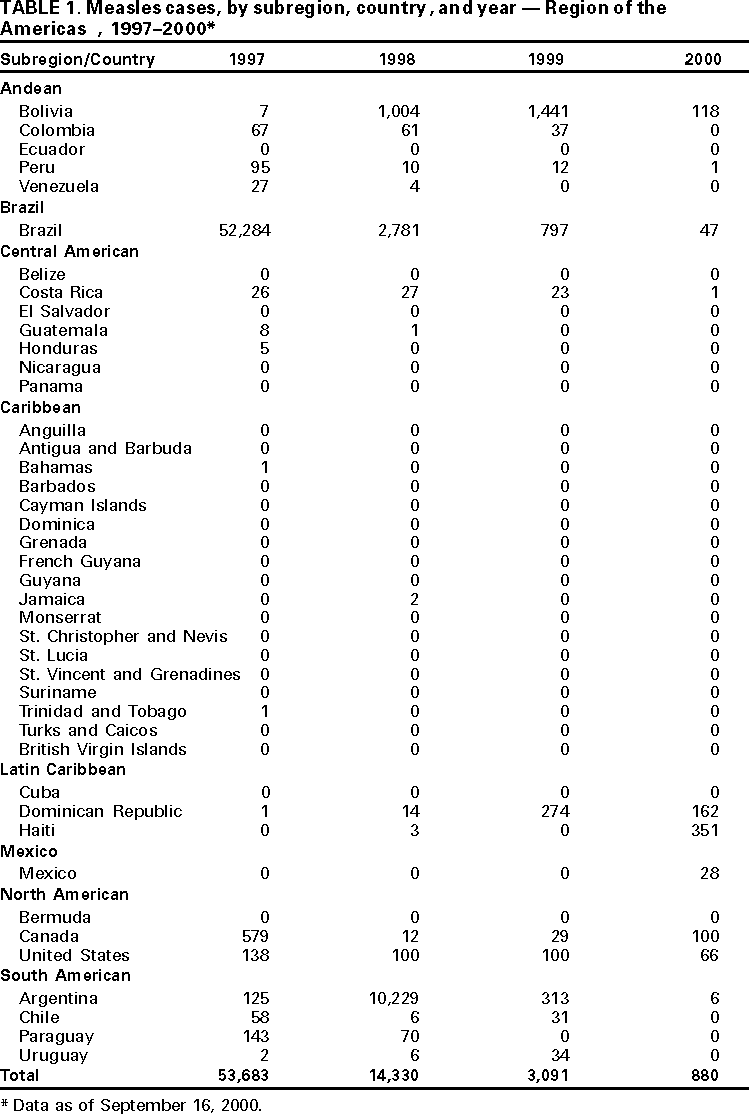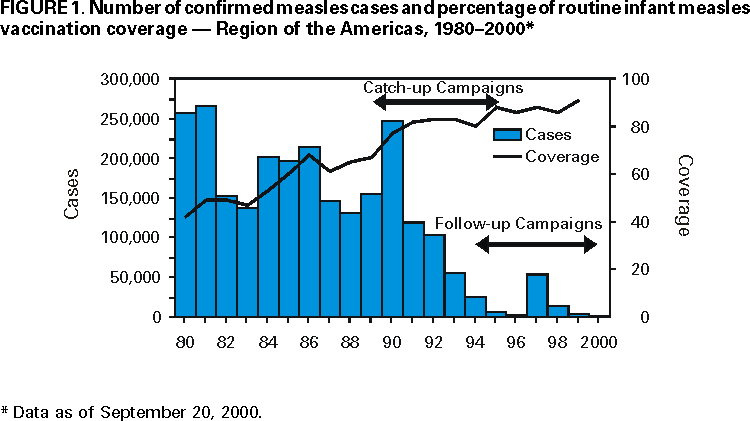 |
|
|
|
|
|
|
| ||||||||||
|
|
|
|
|
|
|
||||
| ||||||||||
|
|
|
|
|
Persons using assistive technology might not be able to fully access information in this file. For assistance, please send e-mail to: mmwrq@cdc.gov. Type 508 Accommodation and the title of the report in the subject line of e-mail. Progress Toward Interrupting Indigenous Measles Transmission --- Region of the Americas, January 1999--September 2000In 1994, countries in the Region of the Americas set a goal of interrupting indigenous measles transmission by the end of 2000 (1). From 1990 to 1996, measles cases declined from approximately 250,000 to an all-time low of 2109 confirmed cases (2). However, a resurgence began in 1997, with 52,284 confirmed cases reported from Brazil (Figure 1) (3) and in 1998, with 14,330 confirmed cases reported from 16 (39%) of the 41 countries that report to the Pan American Health Organization (PAHO). This report summarizes the measles control strategies implemented in the region and measles incidence during 1999--2000 and indicates that the region has made important progress towards interrupting indigenous measles transmission and that achieving this goal is within reach. Measles VaccinationPAHO recommends a three-part vaccination strategy for interrupting indigenous measles transmission: 1) a one-time nationwide "catch-up" campaign targeting all persons aged 1--14 years; 2) routine, "keep-up" vaccination among 1-year-olds; and 3) nationwide "follow-up" campaigns conducted every 4 years, targeting all children aged 1--4 years, regardless of previous measles vaccination status (4). Thirty-nine (95%) of 41 countries in the region conducted catch-up campaigns during 1989--1995 and conducted follow-up campaigns since 1994; routine keep-up coverage in the region increased from 80% in 1994 to 91% in 1999 (2). Measles CasesFrom January 1999 through September 16, 2000, 28 (68%) of 41 countries in the region reported no measles cases, including Cuba, the English-speaking Caribbean countries, and most of Central and South American countries. In 1999, 3091 confirmed cases were reported from 11 countries, 78% fewer cases than in 1998 and 94% fewer than in 1997 (Table 1). In 1999, ongoing endemic transmission occurred in four countries (Bolivia [1441 cases], Brazil [797], Argentina [313], and the Dominican Republic [274]). In 1999 and 2000, Canada, Chile, Costa Rica, Mexico, Peru, Uruguay, and the United States reported measles importations; spread was limited by high vaccination coverage (5--7). From January 1 through September 16, 880 confirmed measles cases were reported in the region, the lowest number recorded in any year during those weeks. Endemic transmission occurred in Argentina, Bolivia, Brazil, the Dominican Republic, and Haiti. Forty (<1%) of the approximately 12,000 reporting municipalities reported confirmed measles cases during this period. Since December 1997, virus isolates were obtained from nine outbreaks in the region (including urine specimens from Argentina, Bolivia, Brazil, Chile, the Dominican Republic, Haiti, and Uruguay) and were analyzed by the measles laboratories of the CDC and Fundação Oswaldo Cruz in Brazil. All virus were genotype D6, which indicates its continued endemic circulation in the region. Argentina. The 1997 measles epidemic in São Paulo, Brazil, spread to Argentina, where 10,667 confirmed cases were reported during 1997--1999. Of these, 10,229 (96%) occurred in 1998 and 313 (3%) in 1999. Cases decreased after a follow-up vaccination campaign was implemented in 1998, with 98% reported measles vaccination coverage among children aged 1--4 years. From January 1 through September 16, 2000, six confirmed cases were reported, a 99% decrease from 1999. These cases all occurred during February 21--March 13, 2000 in the central province of Córdoba, and all but one occurred among unvaccinated persons. Three cases occurred in young adults and two in health-care workers. Brazil. Following the 1997 epidemic, a national follow-up vaccination campaign was conducted (3). In 1999, 797 cases were reported compared with 2781 confirmed cases in 1998. From January 1 through September 16, 47 (1%) confirmed cases were reported. Of these, 15 (32%) were from an outbreak in the western Amazon region, possibly related to an outbreak in Bolivia, 27 (57%) were sporadic laboratory-confirmed cases from São Paulo, and six cases were sporadic cases from other States. In June 2000, a national follow-up vaccination campaign was conducted targeting children aged 1--11 years; reported nationwide coverage was 97%. Bolivia. In 1999, 1441 confirmed measles cases were reported, an increase from the 1004 cases reported in 1998. A measles epidemic began in May 1998, spreading from Yacuiba on the Argentinean border to all regions. A follow-up vaccination campaign was conducted during November--December 1999, with reported national coverage of 98%. However, outbreaks continued during 2000, and house-to-house monitoring indicated that many areas had not achieved 95% coverage during the 1999 campaign. From January through September 16, 118 confirmed cases were reported; 110 were associated with five outbreaks affecting rural, unvaccinated children and young unvaccinated adults who had immigrated from rural areas. The largest outbreak (66 cases) occurred during March--June in a Mennonite community in Santa Cruz that objects to vaccination; this outbreak was identified after a measles outbreak was reported from a related community in Alberta, Canada, linked to travel to the Bolivia's Mennonite community (8). A nationwide, house-to-house vaccination campaign was initiated in September to administer all vaccines used in the routine infant vaccination schedule (diphtheria and tetanus toxoids and pertussis vaccine [DTP], measles, mumps, and rubella vaccine, and oral poliovirus vaccine). Dominican Republic. In 1999, 274 confirmed measles cases were reported. From January 1 through September 16, 162 confirmed cases (18% of the region's total) were reported. Of these, 104 (64%) occurred among unvaccinated persons. The highest age-specific incidence rates were among infants aged <9 months (14 cases per 100,000), children aged 9 months--4 years (five), and adults aged 20--29 years (three per 100,000). Investigations of cases from 2000 indicated that outbreaks occurred in large cities among young factory workers where factories that attract workers from rural areas are located. Haiti. No confirmed cases were reported in 1999. In 2000, an outbreak began in Artibonite; through September 16, 351 confirmed cases (40% of the region's total) have been reported, most from this area (241) and metropolitan Port au Prince (72). Attack rates were highest for children aged 12--23 months (1.5 per 10,000), aged 2--4 years (1.2 per 10,000), and aged 5--9 years (0.8 per 10,000). In June, house-to-house vaccination was initiated for all children aged 6 months--15 years. Reported by: HS Izurieta, L Venczel, P Carrasco, G Tambini, C Castillo, M Landaverde, M Brana, CA de Quadros, Div of Vaccines and Immunizations, Pan American Health Organization, Washington DC. Z Garib, Ministry of Health, C Pedreira, Pan American Health Organization, Santo Domingo, Dominican Republic. R Quiroga, Ministry of Health, O Barrezueta, Pan American Health Organization, La Paz, Bolivia. AM Desormeaux, Ministry of Health, F Laender, J Dobbins, J André, Pan American Health Organization, Port au Prince, Haiti. E Luna, L Brondi, MC Quixadá, S Parise, C Segatto, Ministry of Health, R Prevots, Pan American Health Organization, Brasilia, Brazil. I Micelli, J Vilosio, Ministry of Health, V Dietz, Pan American Health Organization, Buenos Aires, Argentina. National Reference Center for Measles, Dept of Virology, Fundação Oswaldo Cruz, Rio de Janeiro, Brazil. Respiratory and Enteric Viruses Br, Div of Viral and Rickettsial Diseases, National Center for Infectious Diseases; Global Measles Br, Vaccine Preventable Disease Eradication Div, National Immunization Program, CDC. Editorial Note:Countries in the Region of the Americas have made important progress in interrupting measles transmission. Countries have dedicated health-care personnel, resources, and political support to both vaccination programs and intensified disease surveillance. Countries that have adequately implemented all of the PAHO-recommended strategies have successfully interrupted measles transmission (2,4). Effective measles control relies on achieving and sustaining a high level of vaccine-induced measles immunity. Although Haiti and the Dominican Republic have conducted nationwide vaccination campaigns, endemic transmission continues, mainly because measles coverage in the campaigns did not reach 95% (9). Reasons for suboptimal coverage included insufficient supervision and monitoring of house-to-house vaccination and delayed case investigations that prevented rapid assessment of the situation in areas with poor coverage. Sustaining a high level of vaccine-induced immunity to prevent spread of measles from importations is the most effective measles-control strategy. PAHO recommends the appropriate and timely implementation of the following strategies to achieve, maintain, and monitor the interruption of endemic measles transmission in the region: 1) Obtaining >95% routine coverage with measles-containing vaccine in all municipalities. Countries should validate coverage regularly through house-to-house monitoring and/or comparing the number of measles vaccine doses administered to the number of first doses of DTP or the number of doses of Bacille Calmette-Guerin vaccine; 2) Performing follow-up campaigns at least every 4 years and achieving >95% vaccination coverage in all municipalities. Supervisors should verify the vaccination coverage daily during the campaign through house-to-house monitoring; 3) Vaccinating and monitoring coverage among groups at high risk for acquiring or transmitting the disease (i.e., health-care workers, migrant workers, groups philosophically opposed to vaccination, military recruits, and other young adults of rural origin); 4) Conducting reliable, routine surveillance for disease and actively validating data by looking for disease during all house-to-house vaccinations, regular visits to schools and health-care centers by each district's supervisor, including monthly visits to high-risk areas (those where coverage is low, that do not submit weekly reports, with limited access to health services, where tourism or immigration are high, or that have had cases during the preceding weeks); and 5) Investigating all outbreaks, including a) conducting household visits within 48 hours of identifying a suspected case and investigating all contacts and settings where case-patients were during both their exposure periods (7--18 days preceding rash onset) and their infectious periods (from the first respiratory symptoms until 4 days after rash onset); b) collecting blood and either throat or nasopharyngeal swabs or urine specimens at the first contact with the suspected case-patients, sending them to the country's measles reference laboratory within 5 days of taking them and analyzing the serum specimen, and reporting results within 4 days after the laboratory received the specimen; c) identifying the epidemiological links of confirmed cases and evaluating the risk factors involved in every outbreak; and d) verifying the absence of measles exportations/ importations between countries within the region, including determining the viral genotypes to identify endemic or imported viruses. References
Table 1  Return to top. Figure 1  Return to top. Disclaimer All MMWR HTML versions of articles are electronic conversions from ASCII text into HTML. This conversion may have resulted in character translation or format errors in the HTML version. Users should not rely on this HTML document, but are referred to the electronic PDF version and/or the original MMWR paper copy for the official text, figures, and tables. An original paper copy of this issue can be obtained from the Superintendent of Documents, U.S. Government Printing Office (GPO), Washington, DC 20402-9371; telephone: (202) 512-1800. Contact GPO for current prices. **Questions or messages regarding errors in formatting should be addressed to mmwrq@cdc.gov.Page converted: 11/2/2000 |
|||||||||
This page last reviewed 5/2/01
|